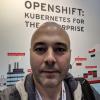It's been just over three years since Solomon Hykes presented the world with the (so far) most creative way to use the tar command: the Docker project. Not only does the project combine existing container-technologies and make them easier to use, but its well-timed introduction drove an unprecedented rate of adoption for new technology.
Did people run containers before the Docker project? Yes, but it was harder to do so. The broader community was favoring LXC, and Red Hat was working on a libvirt-based model for Red Hat Enterprise Linux. With OpenShift 2, Red Hat had already been running containers in production for several years - both in an online PaaS as well as on-premise for enterprise customers. The model pre-Docker however was fundamentally different from what we are seeing today: rather than enabling completely independent runtimes inside the containers, the approach in
OpenShift 2 and libvirt-lxc was to partition the host, re-using the software installed on the host-machine. There were several issues with this model, however, with the most prominent being complexity. Modern deployments are so complex that the process of recreating an application stack (from a puppet manifest, for example) over and over again in dev / test / ops has become too fragile.
This mirrors the problem that we faced with the predominant operational model roughly 20 years ago, when we moved from compiling software on local machines to pre-build binary distribution with rpm. The issue we solved in the “olden days” was that the behavior of a locally compiled application was dependent on the state of the machine at build time and the overhead of this model. We needed binary distribution to achieve a predictable experience of the aggregate software stack.
Today, stacks are so complex and changes in software streams so frequent, that the stack you build is neither what you test nor is what you end up running in production; adding on top of this is the demand for updating applications/systems in place. This brings us back to a situation where the behavior of a production software stack simply becomes dependent on too many variables.
So how do containers, specifically the packaging as provided by the Docker project, marginalize if not outright eliminate these variables? By partitioning and aggregating, of course, which leads to a whole other set of challenges and solutions...but that’s for my next post.
Sobre el autor
Daniel Riek is responsible for driving the technology strategy and facilitating the adoption of Analytics, Machine Learning, and Artificial Intelligence across Red Hat. Focus areas are OpenShift / Kubernetes as a platform for AI, application of AI development and quality process, AI enhanced Operations, enablement for Intelligent Apps.
Navegar por canal
Automatización
Las últimas novedades en la automatización de la TI para los equipos, la tecnología y los entornos
Inteligencia artificial
Descubra las actualizaciones en las plataformas que permiten a los clientes ejecutar cargas de trabajo de inteligecia artificial en cualquier lugar
Nube híbrida abierta
Vea como construimos un futuro flexible con la nube híbrida
Seguridad
Vea las últimas novedades sobre cómo reducimos los riesgos en entornos y tecnologías
Edge computing
Conozca las actualizaciones en las plataformas que simplifican las operaciones en el edge
Infraestructura
Vea las últimas novedades sobre la plataforma Linux empresarial líder en el mundo
Aplicaciones
Conozca nuestras soluciones para abordar los desafíos más complejos de las aplicaciones
Programas originales
Vea historias divertidas de creadores y líderes en tecnología empresarial
Productos
- Red Hat Enterprise Linux
- Red Hat OpenShift
- Red Hat Ansible Automation Platform
- Servicios de nube
- Ver todos los productos
Herramientas
- Training y Certificación
- Mi cuenta
- Soporte al cliente
- Recursos para desarrolladores
- Busque un partner
- Red Hat Ecosystem Catalog
- Calculador de valor Red Hat
- Documentación
Realice pruebas, compras y ventas
Comunicarse
- Comuníquese con la oficina de ventas
- Comuníquese con el servicio al cliente
- Comuníquese con Red Hat Training
- Redes sociales
Acerca de Red Hat
Somos el proveedor líder a nivel mundial de soluciones empresariales de código abierto, incluyendo Linux, cloud, contenedores y Kubernetes. Ofrecemos soluciones reforzadas, las cuales permiten que las empresas trabajen en distintas plataformas y entornos con facilidad, desde el centro de datos principal hasta el extremo de la red.
Seleccionar idioma
Red Hat legal and privacy links
- Acerca de Red Hat
- Oportunidades de empleo
- Eventos
- Sedes
- Póngase en contacto con Red Hat
- Blog de Red Hat
- Diversidad, igualdad e inclusión
- Cool Stuff Store
- Red Hat Summit

